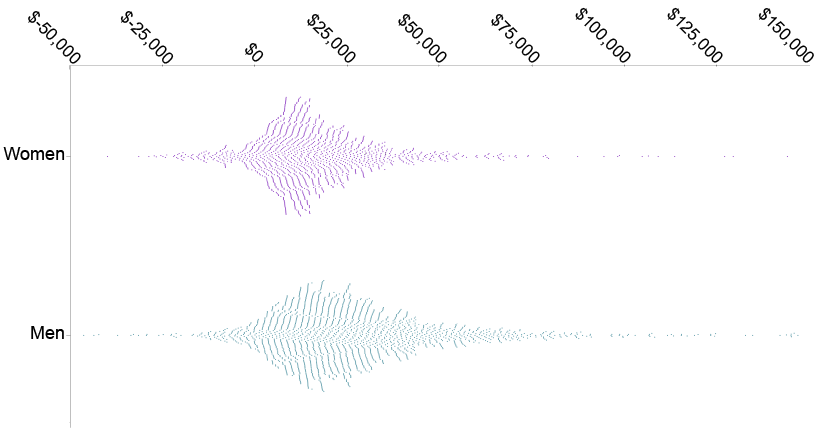Recent Research on the Gender Wage Gap in Utah
Karen Tao, Researcher
TBD

The Utah Data Research Center (UDRC) recently published a research and data narrative on the gender wage gap experienced by the Utah workforce.
About the participants: This research included 67,013 graduates from USHE degree-granting institutions (35,190 women and 31,823 men) and 10,788 graduates from USHE technical college (5,713 women and 5,075 men).
The following are the main findings of this research:
Historical Wage Gap
Utah has consistently ranked with one of the widest gender wage gaps in the nation. This study used the American Community Survey (ACS) annual data to compare the gap in Utah to national metrics. In addition, data from the Utah System of Higher Education (USHE) and the Department of Workforce Services (DWS) were used to study the long-term wage differences between male and female graduates.
ACS data demonstrates that women made 53% of men's median wage in Utah compared to the U.S. earnings ratio of 69% in 2018. For individuals who reported working at least 35 hours a week, Utah women made 69% of men's median wage compared to the U.S. earnings ratio of 80% in 2018. Figure 1 illustrates women's earnings ratio in the U.S. and Utah, as well as Utah men's earnings as a percentage of national men's earnings.

Wage Gap after College Graduation
We then combined wage data from the DWS with graduates who received a certificate from a technical college or a degree from a USHE institution from 2012 to 2014. The UDRC has the unique advantage of conducting longitudinal research by following the same group of graduates sharing similar characteristics and examine the gender wage gap they experience one- and five- years post-graduation.
One year after graduation, women who received a degree from an academic institution made 58.3% of men's wages. In contrast, those who received a certificate from a technical college made 48.4% of men's wages overall.
As the number of hours worked is not available in the DWS data, a proxy called "strong workforce attachment" was used to resemble full-time work. An individual is considered strongly attached to the workforce only if wages were found in all four quarters of the year. The wages in each quarter must be higher than a worker earning the minimum wages working 40 hours a week.
For those who were strongly attached to the workforce, women who graduated from academic institutions made 77.4% of men's wages, while those who graduated from technical colleges made 58.2% of men's wages.
When decomposing the wage gap by age group, more pay equality was observed for graduates in the youngest age group, suggesting that women earn less over time as a percentage of men's wage as they grow older. When studying graduates with the same educational attainment, women with a technical certificate faced the largest wage gap earning 58.2% of men's wages. In comparison, women with a graduate degree had the most pay equality, with women making 80.4% of men's wages.
For the last decomposition, we studied graduates with the same area of study. Among the most popular fields of study at academic institutions, the most equality occurs in the field of education, where women made on average 94.7% of men's wages one year after graduation. In comparison, the highest pay inequality occurred in business management, where women earned 81.7% of men's wages one year after graduation.
For technical college graduates, the trend shows occupational segregation as many fields of study did not meet the requirement of 30 observations for each gender. However, enough data for the healthcare profession were observed and showed that women made 83.1% of men's wages one year after graduation.
The Difference in Wage Growth over Time
Difference-in-differences models were used to examine further the difference in wage growth experienced by men and women over time. The models showed that the difference in wage growth was statistically significant for each type of degree for all cohorts. Figure 2 is a swarm plot illustrating the differences in men's and women's wage growth for graduates with a bachelor's degree who were strongly attached to the workforce. Each dot in the swarm plot represents the change in wages for an individual from one year to five years post-graduation. For example, looking at Figure 2, most data points for women fall below $25,000, while most data points for men are above $25,000. This difference demonstrates that wage growth for most women is less than $25,000, while wage growth for most men is at least $25,000 from one year to five years post-graduation.

Splitting the Wage Gap into Explained and Unexplained Differences
Finally, the mean wage difference was examined using the Blinder-Oaxaca decomposition, which splits the wage gap into explained and unexplained portions. For all cohorts studied, over 70% of the wage gap cannot be explained by age, skills, knowledge, and experience. In other words, when looking at earnings for a female with the same age, experience, and education as her male counterpart, over 70% of the wage difference cannot be explained by human capital measures alone.
Data Limitations
At the time of this study, parenthood status was not available. Future research could be conducted by studying the effects of caregiving on the gender wage gap. In addition, the number of hours worked was not available, hindering the ability to compare the differences in hourly pay. Finally, this study included only graduates from the USHE. Therefore, some post-secondary institutions in Utah were not included, such as Brigham Young University and Westminster College.
Conclusion
Overall, this study illustrates that in Utah, the gender wage gap is bigger than the national average wage gap. Women in Utah consistently make less than men regardless of age, experience, educational attainment, or field of study. Wage data suggests a widening gender wage gap as more time is spent in the workforce. The gap cannot be explained entirely by prior work experience, age, or highest educational attainment.